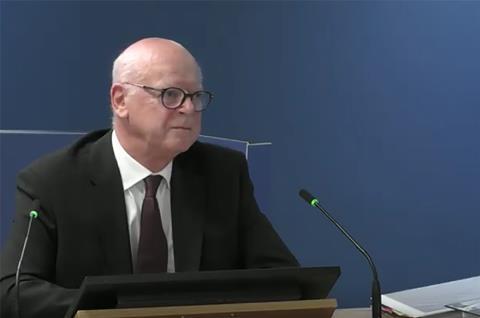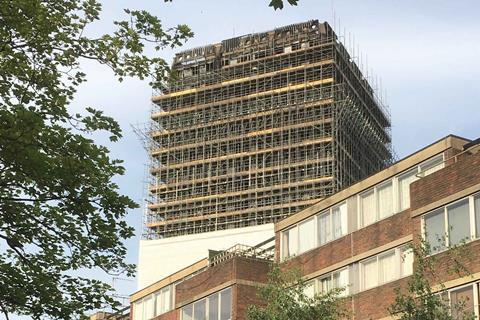Former RIBA president also criticises sloppy attitude, education and failure to learn from previous fires
The UK construction industry has been ŌĆ£sleep-walking towards serious problemsŌĆØ and must now take a long and careful look at itself, the Grenfell Inquiry has been told.
Paul Hyett, a former RIBA president and principal of architect HKS, made the plea for reform yesterday, in the final moments of the inquiryŌĆÖs first module which began in January.

The industry must ŌĆ£take the serious steps necessary to put our house in orderŌĆØ, he said.
Hyett pointed to a number of issues including the reduced emphasis on technical competence in architectural education and industryŌĆÖs failure to learn from a litany of serious fires in the last 40 years.
He also singled out design-and-build procurement for pushing risk ŌĆ£downstreamŌĆØ on to insufficiently trained subcontractors which has all too often led to ŌĆ£design and technical failureŌĆØ.
ŌĆ£I am led to conclude that overall the UK construction industry has indeed been ŌĆśsleep-walkingŌĆÖ for some prolonged period towards serious problems in terms of its performance and conduct,ŌĆØ he wrote in his report for the inquiry.
Hyett, , has spent three days this week being questioned on that report and his views on the circumstances surrounding the ill-fated refurbishment of Grenfell Tower. At the very end of his evidence yesterday afternoon he said: ŌĆ£Our industry and all professions within in ŌĆō mine includedŌĆ” there has to be a lot of very careful contemplation from here on.ŌĆØ
He was the final person to give evidence in module one of this phase of the inquiry, which has been examining in detail the refurbishment that led to the catastrophic spread of the 2017 fire, which claimed 72 lives.
Large parts of the construction industry have developed a very ŌĆśsloppyŌĆÖ attitude to many aspects of our work
Paul Hyett
Module two starts today, looking at the products used in the overcladding project; their testing, certification and marketing.
There will be a further six modules in this second phase. The first phase was concerned with the fire itself with inquiry chair Martin Moore-BickŌĆÖs report on that published last year, backing much of what Judith Hackitt had said in her own review of ║├╔½Ž╚╔·TV Regulations and fire safety which was commissioned by the government in the aftermath of the tragedy.
Hyett said reading the Hackitt report had brought home to him just how much ŌĆ£a culture prevails generally across the UK construction industry in which inadequate importance has been attached to issues of safetyŌĆØ.
He backed HackittŌĆÖs analysis that there has been an emphasis on cost and value engineering to the detriment of safety, with a tendency to transfer responsibility for issues relating to safety ever further ŌĆ£down-streamŌĆØ.
HackittŌĆÖs call for a top-down overhaul of regulatory processes and culture ŌĆ£must not falterŌĆØ, he said, adding: ŌĆ£[Its] impact, both within the UK and around the world, should be profound.ŌĆØ
The Hackitt report was a ŌĆ£wake-up call,ŌĆØ he said. ŌĆ£lt has brought into sharp focus the fact that large parts of the construction industry, and some of the professions that serve it, have in recent decades developed a very ŌĆśsloppyŌĆÖ attitude to many aspects of our work. We need to reflect in an open and constructive manner on these criticisms.ŌĆØ

Hyett, a former vice president for education at the RIBA with 20 yearsŌĆÖ experience as an examiner at parts I, II and III, also pointed to a general ŌĆ£driftŌĆØ within architecture schools away from the technical aspects of architectural delivery. He said most schools had a structural engineer on the staff in the 1970s, while few did today.
He said ŌĆ£there has of late been much more emphasis placed on design aesthetics and the perceived elegance, ŌĆśrichnessŌĆÖ and efficiency of the planning, spatial organisation and appearance of buildings, than on technical aspects of design, particularly as they relate to safety of the building in useŌĆØ.
He blamed the shift in focus in part on the restructuring of the industry as a result of the growth of design-and-build which had led to the architectŌĆÖs authority being ŌĆ£forcibly taken from the professionŌĆØ ŌĆō without any equivalent reduction in responsibility.
ŌĆ£That status quo has produced very serious problems,ŌĆØ he said.
Design-and-build contracts also allow far more swapping-out of products down the line as well as putting pressure on timing and sequencing of projects, with potential consequences for quality.
Hyett concluded: ŌĆ£The problems that led to the Grenfell tragedy do not by any means all lie with the design-and-build process, but it is clear to me that, as indicated by Dame Judith Hackitt in her reports, the events of 14 June 2017 call heavily into question the culture of the UK construction industry as a whole, and particularly its approach to delivering safe buildings, as opposed to delivering buildings safely wherein it has in recent decades established an excellent reputation.ŌĆØ
ŌĆśMisleading literatureŌĆÖ
Hyett was also asked on Wednesday about the pamphlets on Celotex RS5000 issued by the manufacturer. He said the literature ŌĆ£sets out to misleadŌĆØ in relation to the suitability of the product for use on high-rise buildings. He said a competent architect should have been able to find enough information about the product in the sheet for alarm bells to have rung, but that Celotex made it hard for a reasonably competent architect to do their job.
Hyett also said Studio E had no reasonable basis for assuming the rainscreen cladding system proposed for Grenfell was compliant. He said the project team should have been aware in relation to the Celotex data, and also later the Reynobond PE55 data, that assurances were being given based on a complete system that was different to the one proposed for Grenfell in the case of Celotex, and a different product in the case of PE55. Its certification stipulated that test data only applied to one colour variant of the panels, which was not the one used on Grenfell.
Hyett said he was unhappy with a couple of decisions that Rydon made without consulting its client ŌĆō such as infilling the window surrounds with combustible insulation. In addition to the fact that the result aided the spread of fire, Hyett said it was a ŌĆ£significant deviation from the employerŌĆÖs requirementsŌĆØ.
Hyett on design-and-build procurement
Extract from his report to the inquiry
A consequence of design-and-build procurement process, which first emerged in the UK in the late 1970s has been a widespread practice of ŌĆśpackagingŌĆÖ risk and responsibility and passing it ŌĆśdownstreamŌĆÖ: essentially from consultant to sub-contractor. This is, in part, also a consequence of an increased reliance on ŌĆśoff-siteŌĆÖ pre-fabrication.
This has meant that, all too often, design and technical failure has ultimately been a consequence of detailed design and specification work having been carried out by persons (for example draftspersons employed by fabricators or sub-contractors) who have not had the training appropriate for the tasks involved in fabrication detailing.
While there are exceptions, many such people have inadequate knowledge of the ║├╔½Ž╚╔·TV Regulations because they have never received the basic education and training that is routinely given to construction professionals such as architects.
I am alert to the counterargument that within any competent process the work as provided by sub-contractors should be routinely checked by the professional architect appointed ŌĆśupstreamŌĆÖ.
That is, however, to rely on a reactive process which comes late in the design process. What is preferable is a proactive process placing responsibility where it should be for getting the work right in the first instance.
lt is the case that many sub-contractors produce consistently highly competent work informed by great expertise, and my comments should not be taken as a universal criticism of all construction sub-contractors many of whom bring welcome expertise and experience to a project.
Having given careful consideration to the above issues, and in the light of both the Grenfell Tower tragedy, and the Hackitt Report, I am led to conclude that overall the UK construction industry has indeed been ŌĆśsleep-walkingŌĆÖ for some prolonged period towards serious problems in terms of its performance and conduct.




























No comments yet